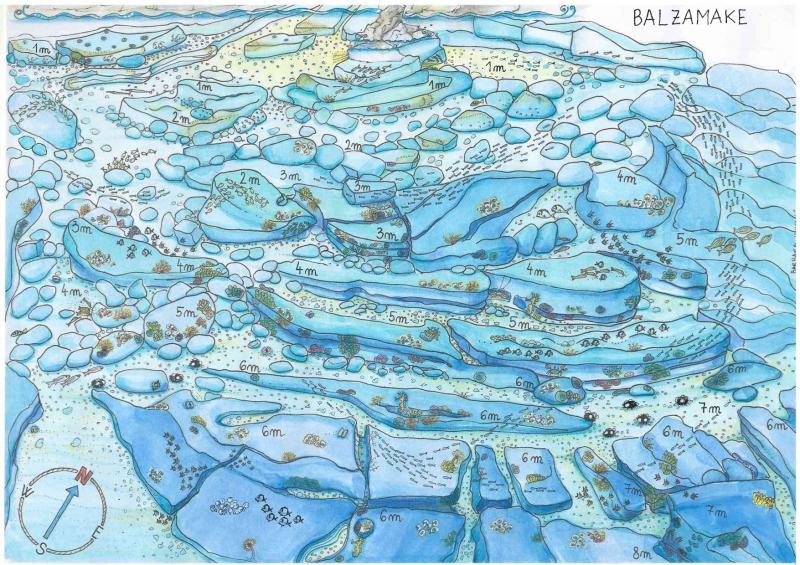Snorkeling location and underwater map
Balzamake
This snorkeling location is located within the Zlatni Rt Forest Park, better known as Punta Corrente, in the immediate vicinity of Cape Kurent. The easiest way to get to Balzamake Beach is to follow the directions to Lovor Restaurant, which is located right on Cape Kurent. Then, continue along the walking path for about 300 meters in the direction of Škarabica Bay. On the left side of the walking path, there is a low wall against which bicycles are often propped up, as this is the most common means of transport in this protected park-forest. When the wall ends, go down to the rocky shore, which is partially covered with pine trees.
The shore slopes down towards the sea, but if you look at it more carefully, you will notice that the lowest part of the sunbathing area is slightly curved in the shape of a bubble and enters the sea.
Right next to the shore, a small rock is jutting out of the sea. When you look towards the open sea on the left, you will notice the islets of Veliki and Mali Piruz, and on the right the island of Sveti Andrija.
This is where you can start exploring this snorkeling location. Be careful when entering the sea because the rocks are covered with smooth algae and can be very slippery.
The small rock jutting out of the sea has a gap in the middle through which you can look to the other side. If you look more closely, you can also find sea slugs hiding behind a black sea sponge or a sleepy crab carrying a sea sponge on its back. Head along the right side of the small rock towards the sea.
In the shallows there are small white pebbles which, as you go deeper, turn into large stones. All the stones are covered with a thick carpet of various brown and green algae. A special decoration on the stones are whitish fans bent into a funnel, resembling flowers. This is padina pavonica, an alga which is very widespread here.
This location is like a very lively crossroads for small fish as schools of fish pass by from all directions.
Keep swimming deeper and you'll notice two elongated steps that look like someone cut them off a long time ago. They are overgrown with various brown algae, and are decorated with large yellow sponges mixed with green velvety sponges. The walls of the steps are layered, and their shady crevices are inhabited by red and green algae of various shapes. Between the steps, the bottom is strewn with small stones where violet sea urchins live and cover themselves with shells or pebbles.
However, the most interesting inhabitants of this location are the seahorses that can be found on the slopes of the steps and in small crevices similar to caves at a depth of 4 to 7m.
Their color varies from white to intense yellow, and they can be dotted with stripes or dots. Their head is decorated with branched appendages like antlers. They swim very slowly and stalk their prey almost motionless, and they need very good vision. If you get closer to them, you will notice that they are watching you closely, most likely in fear.
They are not easy to spot because they have excellent camouflage. By their color or shape, they resemble sponges and algae in the environment.
This snorkeling location is abundant with wandering fish such as the mullets, sea basses, sea breams and the small amberjacks. Among the large stones, the painted combers, pointed-snout wrasses, Mediterranean rainbow wrasses, damselfishes, common two-banded sea breams, and the saddled sea breams have found their homes.
At the bottom you can notice empty Noah's Ark shells and abalones, with an iridescent nacre inner side, scattered between the rocky steps. They are reliable proof that an octopus lives nearby...
Note
If you want to see a seahorse, keep in mind that it is not easy to spot even for skilled divers. It takes a certain amount of time for the eyes to get used to the seascape, to notice it among the algae and spot its small movements that give it away. They look like fairy creatures and are very interesting to watch, but do not touch or disturb them. Recent research has shown that seahorses develop strong bonds with their partners and have certain rituals as a couple. If their social structure is disrupted, their reproduction rate also decreases. Due to their delicate biology and the complexity of reproduction, they are a protected species in the Adriatic Sea.
This snorkeling location is located within a protective barrier marked by a cork line. Keep in mind that the line represents the limits of safety and pleasant diving because the maritime traffic here is very lively.
If you want to continue to explore further, it is important that you stay within the protective barrier.
Download the map Snorkeling map - Balzamake

